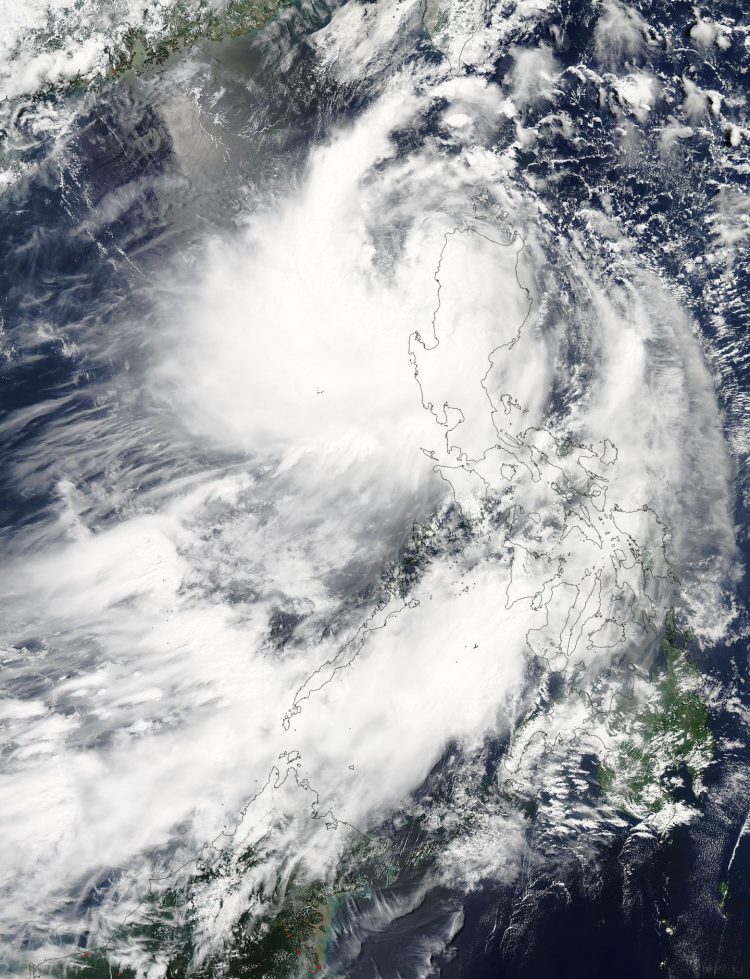NASA sees Tropical Storm Linfa exiting northern Philippines

On July 5 at 05:25 UTC (1:25 a.m. EDT) the MODIS instrument aboard NASA's Aqua satellite captured this image or Tropical Storm Linfa moving into the South China Sea. Credits: NASA Goddard MODIS Rapid Response Team
On July 5 at 05:25 UTC (1:25 a.m. EDT) the MODIS (Moderate Resolution Imaging Spectroradiometer) instrument aboard NASA's Aqua satellite captured a visible image or Tropical Storm Linfa moving into the South China Sea.
The storm appeared to be somewhat elongated because of wind shear and had weakened as a result of moving over land. MODIS imagery also showed an isolated area of deep convection, thunderstorms and clouds, pushed over the southwest quadrant of the low-level center, as a result of northeasterly wind shear.
The Joint Typhoon Warning Center noted that animated multispectral satellite imagery showed that the low-level center of circulation is exposed to outside winds.
Tropical Storm Linfa was about 295 nautical miles (339 miles/1,639 km) north-northwest of Manila, Philippines. It was centered near 19.2 North latitude and 119.2 East longitude. Tropical Storm Linfa has maximum sustained winds near 45 knots (51.7 mph/83.3 kph). It was moving to the north at 5 knots (5.7 mph/9.6 kph).
As Linfa continues to exit the northern Philippines, some warnings remained in effect for July 5. Public storm warning signal #2 remained in effect in the Luzon provinces of Batanes, Cagayan including Calayan and Babuyan group of Islands, Apayao, Kalinga, Ilocos Norte, Ilocos Sur and Abra. In addition Public storm warning signal #1 remained in effect in the Luzon provinces of Pangasinan, Isabela, Benguet, La Union, Mt. Province and Ifugao.
Linfa is moving north and is forecast to then curve northwest and move between Taiwan and mainland China by July 9. The Joint Typhoon Warning Center expects Linfa to strengthen a little before wind shear brings about its dissipation in the Taiwan Strait sometime around July 10.
Media Contact
All latest news from the category: Earth Sciences
Earth Sciences (also referred to as Geosciences), which deals with basic issues surrounding our planet, plays a vital role in the area of energy and raw materials supply.
Earth Sciences comprises subjects such as geology, geography, geological informatics, paleontology, mineralogy, petrography, crystallography, geophysics, geodesy, glaciology, cartography, photogrammetry, meteorology and seismology, early-warning systems, earthquake research and polar research.
Newest articles

Economies take off with new airports
A global study by an SUTD researcher in collaboration with scientists from Japan explores the economic benefits of airport investment in emerging economies using nighttime satellite imagery. Be it for…

CAR T–cell immunotherapy targets
Pan-cancer analysis uncovers a new class of promising CAR T–cell immunotherapy targets. Scientists at St. Jude Children’s Research Hospital found 156 potential CAR targets across the brain and solid tumors,…

Stony coral tissue loss disease
… is shifting the ecological balance of Caribbean reefs. The outbreak of a deadly disease called stony coral tissue loss disease is destroying susceptible species of coral in the Caribbean…





















